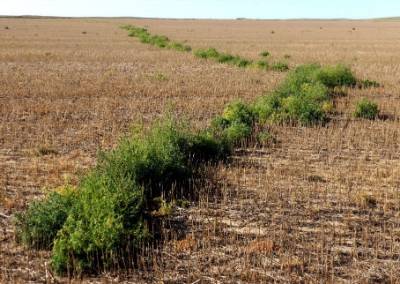Herbicide Resistance
(by Dr. Fabian Menalled, Professor and Extension Cropland Weed Specialist, MSU)
Download Weed Post on Herbicide Resistance as PDF (includes word puzzle)
Modern weed science was born largely out of advances in chemistry that emerged following World War 2 and grew in close association with crop science. Since the early 1950s and following the discovery of 2,4-dichlorophenoxyacetic acid (2,4-D), synthetic herbicides have been at the foundation of both weed science research as well as the intensification and expansion of industrialized agriculture. Currently, an estimated 915,000 metric tons of herbicide active ingredients valued at $15.5 billion are used each year to control weeds worldwide. In the US, 61% of wheat crops are regularly treated with herbicides from just two site of actions: acetolactate synthase (ALS) inhibitors and acetyl CoA carboxylase ACCase inhibitors)].

| Even though most kochia plants were killed with glyphosate, a track of healthy kochia plants grew when an herbicide resistant plant tumbled across the field in the wind. Photo by Andrew Wiersma, Colorado State University. |
To reduce the spread and impact of herbicide resistance, weed managers must recognize that this problem transcends any one location (e.g. farm, ranch, natural area) and requires coordination between local practices and regional actions. Weed management should strive to slow selection of herbicide resistant biotypes by reducing herbicide use and maintaining susceptible weed genotypes across the landscape (i.e., utilizing less than optimal tactics). Practices such as diversified crop rotation, cover crops, intercropping, grazing, biological control, mowing, hand-pulling, and others should be integrated with herbicides to reduce selection pressure, enhance competition from desired vegetation, and increase weed suppression. Early detection of resistant biotypes and their immediate eradication is one of the most effective approaches to prevent their spread. While highly effective in terms of weed control, heavy reliance on a few herbicides has resulted in an unintended but predictable consequence. Herbicide applications selectively kill susceptible plants. However, some individuals already present within a population, usually at a very low frequency, are not killed due to an innate ability to survive and reproduce after treatment with an herbicide dose that would normally be lethal. These individuals are herbicide resistant. Currently, more than 485 biotypes (i.e., a group of organisms having an identical genetic constitution) from 252 weed species are resistant to 163 of 281 different herbicides. In Montana biotypes of wild oat, green foxtail, kochia, Russian thistle, Persian darnel, and horseweed have been identified to be resistant to different herbicides (visit http://www.weedscience.org/ for more information). Three of these species (kochia, Russian thistle, and horseweed) have developed resistance to glyphosate. Also, the alarming increase in weed biotypes resistant to herbicides targeting different sites of action, referred to as multiple resistance, has created major weed management challenges. In Montana, wild oat and kochia biotypes have been identified as being resistant to multiple modes of action.
